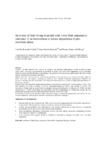| dc.contributor.author | De-Rosende, Iván | |
| dc.contributor.author | Simón Sanjuán, Luisa | |
| dc.contributor.author | Santos-del-Riego, Sergio | |
| dc.date.accessioned | 2019-02-22T12:08:45Z | |
| dc.date.available | 2019-02-22T12:08:45Z | |
| dc.date.issued | 2016-08-16 | |
| dc.identifier.citation | De-Rosende Celeiro I, Simón Sanjuán L, Santos-del-Riego S. Activities of daily living in people with lower limb amputation: outcomes of an intervention to reduce dependence in pre-prosthetic phase. Disabil Rehabil. 2017; 39(18): 1799-1806 | es_ES |
| dc.identifier.issn | 0963-8288 | |
| dc.identifier.uri | http://hdl.handle.net/2183/21930 | |
| dc.description.abstract | [Abstract] PURPOSE: The main objective was to assess the change in the functional independence in basic activities of daily living (ADL) following a pre-prosthetic intervention in people with lower-limb amputation (LLA). Secondary objectives were to identify the factors contributing to the success of this intervention, and to analyze the effects on the presence of unmet needs for home adaptation.
METHOD: The ADL intervention was early and pre-prosthetic; it was focused on six self-care activities. Fifty-two adults with LLA, who required assistance in self-care, were included. Functional independence (Barthel) was assessed at baseline and after intervention (T2). Successful intervention was defined as independent performance of all self-care activities.
RESULTS: There was a significant improvement in Barthel scores between baseline and T2 in toileting (p < 0.001), bed-chair transfers (p < 0.001), dressing (p < 0.001), bathing/showering (p < 0.001), and feeding (p = 0.025). The proportion of homes with an unmet need for adaptation decreased significantly in bathroom (p = 0.008) and other internal areas (p = 0.031). Intervention was successful for 61.5% of participants. In a multivariate model, age was significantly associated with successful intervention (OR 0.66, 95%CI 0.52-0.83).
CONCLUSIONS: A short and pre-prosthetic ADL intervention improves functional independence and reduces the need for home adaptation. ADL programs should be included in rehabilitation strategies. Implications for Rehabilitation Because basic activities of daily living (ADL) can be seriously compromised after a lower-limb amputation, it is important for this population to improve or maintain their level of independence. A short and pre-prosthetic ADL intervention is an effective method for an early recovery of functional independence in self-care activities and promotes home adaptation. Age is an important determinant of functional recovery, and most subjects can achieve independence in basic ADL regardless of the level of amputation. A pre-prosthetic ADL program should be included in rehabilitation strategies for adults with lower-limb amputation. | es_ES |
| dc.language.iso | eng | es_ES |
| dc.publisher | Taylor & Francis | es_ES |
| dc.relation.uri | https://doi.org/10.1080/09638288.2016.1211757 | es_ES |
| dc.rights | This is an accepted manuscript of an article published by Taylor & Francis in "Disability and Rehabilitation", avaliable online at Taylor & Francis Online. | es_ES |
| dc.subject | Activities of daily living | es_ES |
| dc.subject | Amputation | es_ES |
| dc.subject | Lower limb | es_ES |
| dc.subject | Occupational therapy | es_ES |
| dc.subject | Outcomes | es_ES |
| dc.title | Activities of Daily Living in People With Lower Limb Amputation: Outcomes of an Intervention to Reduce Dependence in Pre-Prosthetic Phase | es_ES |
| dc.type | info:eu-repo/semantics/article | es_ES |
| dc.rights.access | info:eu-repo/semantics/openAccess | es_ES |
| UDC.journalTitle | Disability and Rehabilitation | es_ES |
| UDC.volume | 39 | es_ES |
| UDC.issue | 18 | es_ES |
| UDC.startPage | 1799 | es_ES |
| UDC.endPage | 1806 | es_ES |






